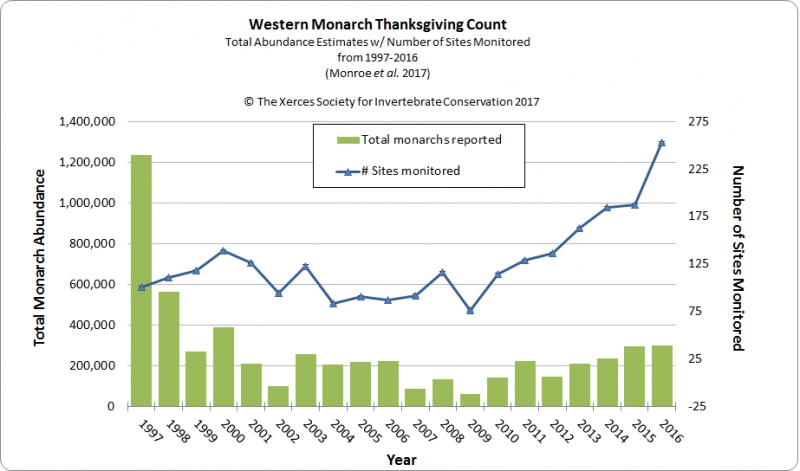A survey of monarch butterflies overwintering in California shows that the population has not rebounded. Although the total number of monarchs counted this year was greater than last, the difference is due to a large increase in volunteer effort. Counts at major sites were down when compared to recent years. Volunteers with the Xerces Society’s Western Monarch Thanksgiving Count visited 253 sites and tallied a total of 298,464 monarchs—a fraction of the 1.2 million monarchs recorded in the late 1990s. Key sites such as Pismo Beach and Natural Bridges saw lower populations this year, and all but one of the 15 sites which have been continuously monitored since 1997 had lower counts than in the prior year. There are a few positive findings from this year’s results. Four new sites were documented in Southern California and a private site in Monterey County hosted over 39,000 butterflies—the largest aggregation observed in the last 10 years on the California coast.
Monarchs from as far away as Idaho, Utah and Arizona converge to spend the winter in tree groves along the Pacific coast from Mendocino County, California, to northern Baja, Mexico. This gathering of monarchs provides a unique opportunity to gauge the health of the monarch population from the western United States.
Data gathered each year by WMTC participants was recently used in an analysis which documented a 74% decline in California overwintering population since the late 1990s—mirroring the steep decline observed at the monarch overwintering sites in the state of Michoacán, Mexico and where a subset of western monarchs migrate to.
This year marks the 20th anniversary of the Western Monarch Thanksgiving Count, the longest running and most comprehensive effort to monitor overwintering monarchs in California. The count happens during a three-week period centered on Thanksgiving. Biologists, land managers, and citizen scientists visit overwintering sites year after year to monitor the butterflies. Volunteer participation continues to grow and this year, over 100 volunteers monitored a record 253 sites, the single greatest effort since the count began in 1997. This big uptick in effort is also the results of a major effort in Santa Barbara County being led by WMTC regional coordinators Jessica Griffiths & Charis van der Heide and researchers Prof. Francis Villablanca of Cal Poly and Dan Meade who are revisiting a similar survey completed by Meade in the 1990s.
Source: Xerces Society, Feb 8, 2017
https://www.indybay.org/newsitems/2017/02/08/18796294.php

- Login om te reageren
